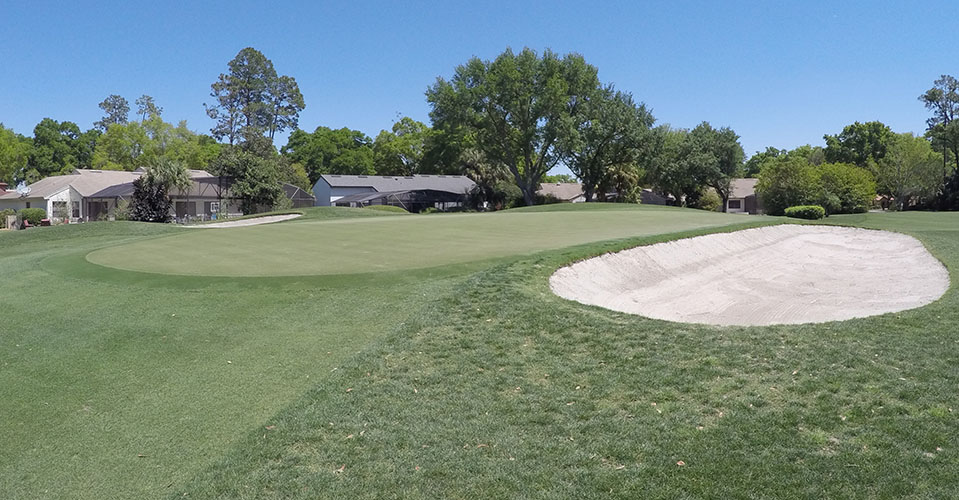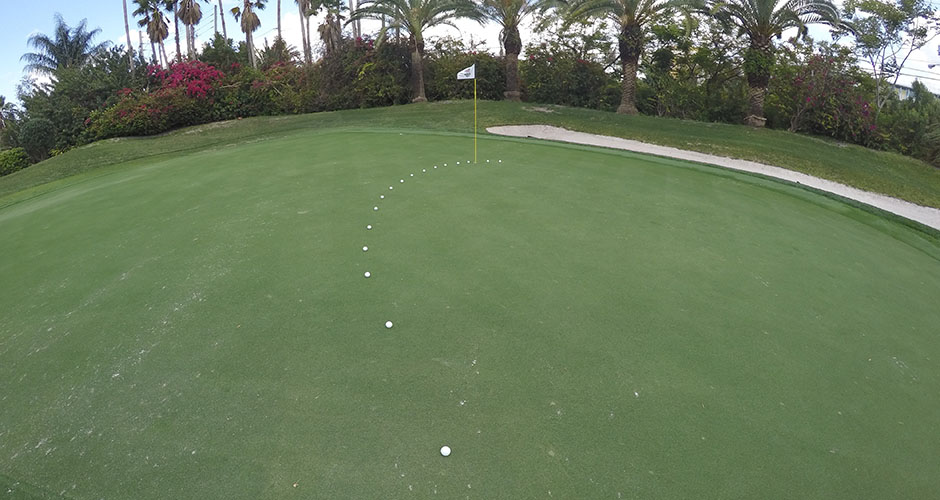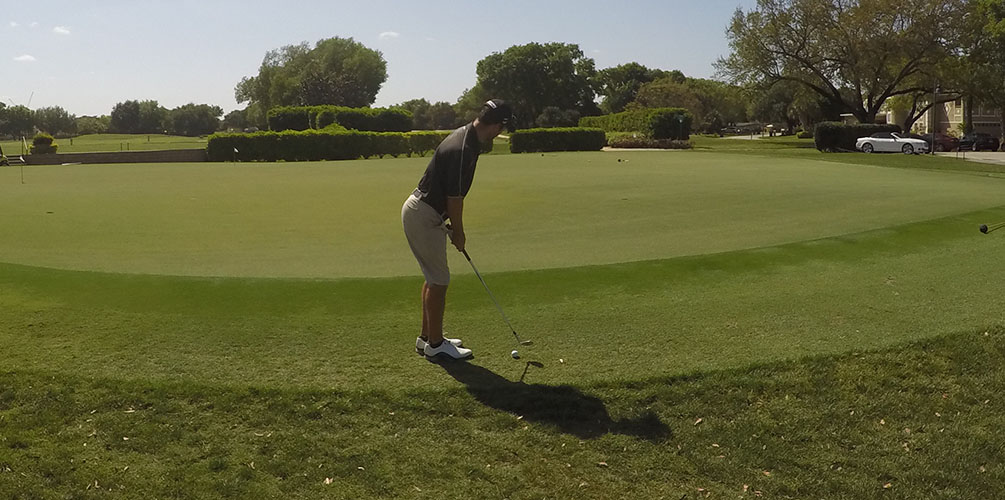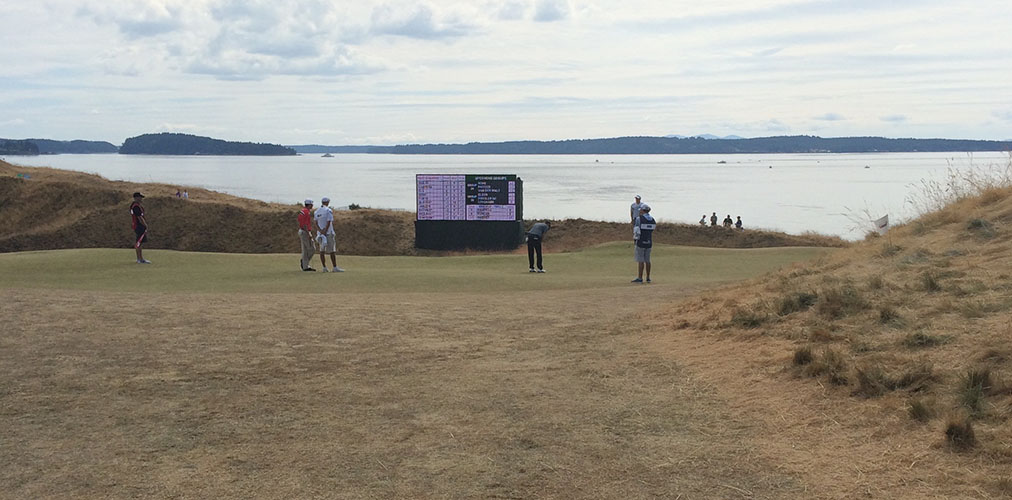Any golf course can be challenging one day and easy the next. Fast and firm conditions will always be more challenging than soft and slow. Be very aware of the course conditions before you tee off.
FAST AND FIRM
Playing golf when the fairways are rolling out and the greens are firm can make for a very long day. Each time you think your drive is perfect it rolls too far and ends up in the rough or a bunker. Perfect chips can end up 20 yards off the green. You hear these stories all the time and most people struggle in these conditions because they haven't learned how to adapt properly.
Hitting the fairways is very important when the conditions are fast. Whether your ball is 1 inch or 20 yards into the rough, it's much harder to spin it and stop it on the greens. The ball can come out soft or uncontrollably fast. Players can make double bogeys from the most innocuous positions. When the fairways and greens are rolling out:
- Straight is Best - Any curve you put on the golf ball is magnified by the conditions. Reduce the amount of curve on your shot the best you can. This will give you the best chance to hit the fairway and hold the green.
- Club Down - Since the ball is gonna travel much further with the roll out, you can tee off with a lot less club. The more loft on the club, the easier it is to hit the ball higher and get it to stop on both fairways and greens.
Once you find the fairway from the tee shot its time to hit the approach. When hitting approach shots to greens that are firm and fast, use the keys:
- Create consistent spin on the ball - Draws and fades land and react very differently on firm greens. Balls that have draw spin will not stop as fast as balls that have cut spin.
- Higher trajectory than your normal shot - Hitting shots with a higher trajectory will help make the ball stop faster on firm greens. To hit the ball higher, move the position of the ball slightly forward in your stance. Keep the weight on the heels of your feet instead of forward or on your toes. Doing this will allow you to feel a sense of pulling up on the ball rather than falling into, or driving the ball. Although hitting it high will make the ball land softer, it allows the wind to affect it more. Be sure to consider all the variables before choosing your shot.
- Forget About The Pin - When the greens are firm and the pins are in the corners of the greens, it makes it very difficult to get the ball close. Lots of times the area to land the ball is smaller than a basketball hoop. Other times you have to land it short and hope for a bounce to get it close. This is when par and 30 feet away from the hole is your friend. One of the hardest things to do in golf is aim away from the flag.
 One great strategy or practice method is to play a round of golf with no pins. This forces the player to hit it to the middle of every green. It will not only surprise how well you hit the ball but how well you score.
One great strategy or practice method is to play a round of golf with no pins. This forces the player to hit it to the middle of every green. It will not only surprise how well you hit the ball but how well you score.
Chipping
Chipping on fast greens can be very difficult because the slightest mishit can be magnified dramatically. This makes the bump and run a very popular shot when playing fast and firm greens. Getting your ball on the ground as quickly as possible will help to eliminate variances. Putting from off the green can often be your best option.
Putting
Putting on fast greens is great for some and terrible for others. People who die their putts in typically have a much easier time adjusting to fast greens. These 3 tips will help when the greens are slick:
- Dead Weight - The goal on fast greens is to get your ball to stop as close to the hole as possible. Putts that go in the hole should be going in on their last revolution. Players who hit their putts firm will reduce the size of the hole and the chances of the ball going in the hole.
- Play Maximum Break - All the slopes on the greens will be magnified dramatically when the greens are fast. Your ball will be rolling more slowly, thus giving it more time to be effected by gravity. Play the most break that you can see on every putt.
- Soft Hands - A death grip where your knuckles are turning white will destroy your feel. Keep your hands soft and supple to provide you with the maximum feel and speed control.

SOFT AND SLOW
After a big storm has passed, the course is usually pretty wet. Playing in these conditions can make a course play much longer. But length doesn't always mean more difficult. Soft conditions make it easier to hit the fairway. Your ball will not be rolling very far, therefore ANY shot works from the tee box. If you play a draw, then aim right and draw it. Your natural tee shot will be your best bet. Most of the adjustments you need to make begin in the fairway:
- Choke Up - Normally the ground provides a little resistance against the club and helps us to make contact. But when it's wet out, shots from the fairway more closely resemble a fairway bunker. When playing from wet conditions in the fairway you want to choke up on the club a little bit. This will help you to make solid contact with the ball instead of using any bounce on the club.
- Know Your Carry Yardages - The ball will not move when it lands on the green. The distance it carries is the distance it will travel. Most amateurs don't take enough club to begin with and this problem is magnified in soft conditions. Check your ego at the door. Be sure to take enough club when the conditions are soft and don't be surprised when the stops quickly.
- Mud Balls - Crazy things happen when mud gets stuck to your golf ball. As a general rule, if the mud is on the left side of the golf ball it will squirt right and vice versa. Hitting mud balls can be a like throwing the dice on a craps table. You never know what will happen.
Chipping
Chipping on soft conditions can make any player look bad no matter what their skill level. Sliding the club under the ball just doesn't work. You end up chipping it short and looking like a fool. Instead try these chipping pointers:

- Stand Tall - Be very aware of your posture when chipping from wet lies. Standing tall will help to reduce the chances of hitting behind it.
- Stand Closer to The Ball - Standing closer to the ball will raise the heel of the club dropping the toe on the ground. This makes it much easier to create clean contact when chipping. Your club will have much less of a tendency to dig into the ground uncontrollably.
- Carry The Ball Farther - Many people have a tendency to try to hit the ball harder when chipping in soft conditions. A better strategy is to simply pick a landing spot that is much closer to the hole and swing accordingly.
Putting
Putting on slower greens can be difficult because it's harder to get the ball to the hole. You need to change the picture in your head on slow greens. Picking a spot that is a few feet past the hole can be a helpful guide to getting the ball to the hole. Greens that are slower typically will have less break because the initial hit is so strong that it stays straight until it starts to lose speed. Playing less break and hitting the putt firm is almost always the answer.
